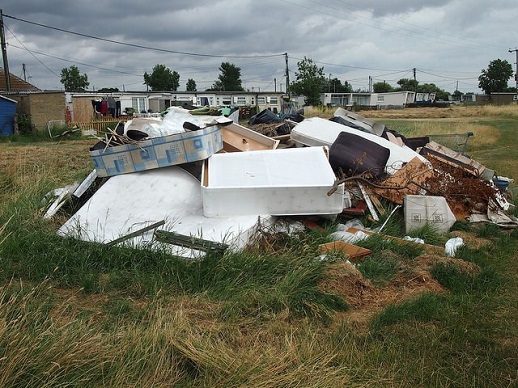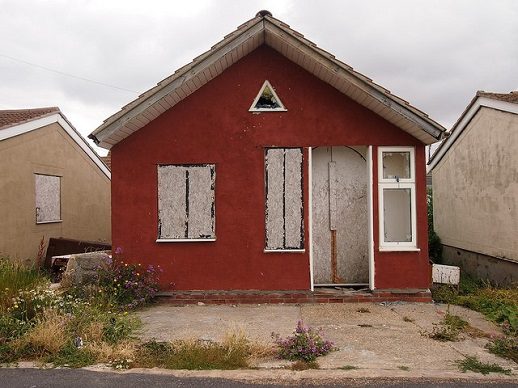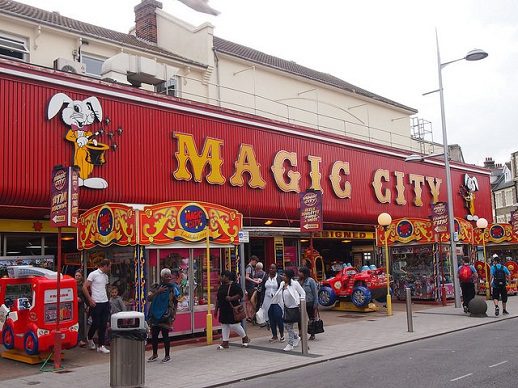Words and images by Tom Bolton
Walking the coastline of Britain – all of it – Jo and I reached the St Osyth Marshes, some way east of Clacton. First impressions suggested a landscape of nothing but marsh and sea wall, but the emptiness resolved itself as details came into focus. Swallows lined up on turquoise electricity cables, luminous against a darkening sky. Trails of small Gatekeeper butterflies rose from the long saltmarsh grass around our feet. A cloud of sparrows, too many to count, settled and resettled on a chainlink fence. Out on the saltings clean, white, angular egrets spotted us hundreds of yards away and lifted up into the broad sky. Oyster pits beyond the seawall were disused, taken over by sea purslane.
Before the 1930s there was almost no settlement here at all. St. Osyth, east of Point Clear, was named after a dissolved abbey and a forgotten saint. Between its surviving flint gatehouse and the North Sea, marsh occupied the whole of the Tendring Peninsular. Since then it had acquired isolated settlements, temporary structures and peripheral habitation.
Lee-over-Sands was a collection of polar huts constructed with whatever lay to hand. It was presided over by a concrete box, elevated on four legs, its purpose not apparent. The seawall drew us across the saltings to Seawick, a static caravan park and some slightly more permanent buildings. The 1960s map shows a crossroads with a pub, St. Osyth Marsh on all sides. Since then Seawick had arrived. It was perhaps the cheapest place to live in Southern Britain, with caravans advertised at £160 a month.
We stopped for lunch at a single-storey pre-fab café and members’ club called the Village Inn Pub, set among bungalows. Admiring a husky dog behind a picnic table outside, we spoke to its owner, who sported a white moustache and home-inked tattoos. He complained that the dog had lost his nerve, getting spooked one night for no apparent reason, and had not been the same since. The dog hid under the table. “Maybe he’ll get over it?” we suggested, but his owner said it had been 18 months and he thought it was too late.
Looking back from the seafront, we saw a summer storm gathering. It was raining to the south over the Dengie Peninsula. The twin blocks of Bradwell-on-Sea power station reflected low light on the horizon. Bradwell was the first of the UK’s nuclear power stations to enter decommissioning when it closed in 2002. It was back in the news that week, as the new Prime Minister delayed the Hinkley C reactors in Somerset. French and Chinese investment was proving hard to secure, the sums had never added up, and Bradwell was further down the same queue. Both the money and the reactor, the Hualong One, would be arriving from Beijing.
The Dengie, pronounced with a soft ‘g’ as we discovered through trial and error, was official wilderness. The power station lay close to St. Peter-on-the-Wall, a chapel built by a Lindisfarne monk, St. Cedd, in 654. It was the end point of a popular annual pilgrimage route. The author Robert Macfarlane had visited for his book The Wild Places, the only location in the South-East to make his shortlist of true British wildernesses. He slept on his back by the sea wall, contemplating the planes passing overhead on their way up the Thames to City Airport.
Another Martello Tower marked the transition from Seawick to Jaywick. The towers were ranged along the Tendring peninsula, from Point Clear to The Naze, and had been built in the early 1810s against Napoleonic invasion. Presumably the Navy feared a flanking move, French ships slipping round Kent to rush Essex. The towers were re-equipped for World War Two and still looked menacing, ready in case things flared up again.
Jaywick was notorious as the most deprived council ward in England. It was an anomaly, a plotland resort where 1930s Londoners built holiday homes on empty sands west of Clacton-on-Sea. After the war it supplied much-needed illegal housing. While other plotland developments were bulldozed, Jaywick survived, but was badly hit by the disastrous 1953 North Sea flood, in which 35 residents drowned. Essex County Council developed special planning restrictions for Jaywick, and streets remained unadopted, chalet-style houses in poor repair, and the place sliding towards shanty town status. Despite coastal defences, the houses were still highly vulnerable to a tidal surge.
Unemployment and drug and alcohol problems had been played out in Channel 5’s controversial Jaywick: Benefits by the Sea, broadcast in 2015. However, the seawall was busy and many of the houses decorated in eccentric seaside styles, one bungalow painted with shamrocks. An enormous seated Buddha occupied one end of a suspended, first-floor conservatory. A woman with a small dog was looking for another, which was elderly and had wandered off on a dementia stroll.
On the beach, a group of boys took turns to throw stones at a warning sign, from very close up. On the horizon an array of wind turbines had become visible, off Clacton. They seemed to float just below the vanishing point, drawing down energy like Walter De Maria’s Lightning Field sculpture in the New Mexico desert. This was the Gunfleet Sands windfarm, jointly owned by the Danish firm DONG Energy and the Japanese Marubeni Corporation.
A 1980s housing estate, built on the site of the demolished Clacton Butlins, showed our destination was approaching. Suddenly, the sand became fine and the beach busy. Behind the Martello Inn Toby Carvery, a line of coaches were parked up with livery suggesting flight: Swallow, The King’s Ferry, the galloping horse logo of Marshall’s. As we approached the pier, the summer Saturday was in full swing. An Afro-Caribbean beach party, a hundred yards long, looked like a church outing but was equipped with a sound system, industrial drinks coolers and chicken barbecues. The pier was overrun with chaotic ice-cream queues, the PA playing Spirit in the Sky.
As we crossed Clacton town centre to the station for our train home, we passed the constituency office of Douglas Carswell, the country’s only UKIP MP. The appeal of the coast had always been its marginality, a place where outsiders washed up. It rarely felt ordinary. Now, it seemed suddenly and unexpectedly central. Ripples had rolled out until they hit the concrete seawalls, and now they had reflected back. The sea defences were up, and the only thing we could think to do was to keep returning to the edge to trace and record.


